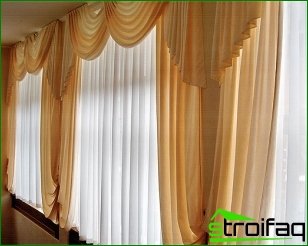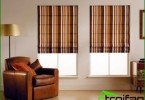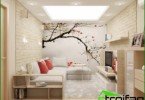Curtains are not only one of the most important elements in your interior, but also a necessary tool designed to regulate lighting. What you need to know to choose them correctly?
Classic curtains
The charm of simplicity. For the office and living room, made in the classical style, long straight curtains with a lambrequin are best suited. The design of such curtains will require plain fabrics with a rich color. You can also use fabric with a bright print. This option visually increases the height of the ceiling and mask the aesthetic imperfections of the windows..
Layers of curtains. Classic curtains include five elements. The base is a French curtain. But you can also use the Roman, Austrian or English curtain. The second layer is tulle. The third is the under-curtains or work curtains that regulate the access of natural light to rooms. They can be picked up with decorative curtains (a quarter layer) or hang freely. As the final layer, a lambrequin is used, which is a drapery of the upper part of the window. But you can do without the last layer.
English curtains
A great alternative to tulle. Such thin curtains are best suited for the interior, made in the classical and English style. The curtain is represented by a smooth panel having rounded folds in the lower part. The design of such curtains will require noble fabrics with a fine print or jacquard pattern..
Austrian curtains
Even more luxury. Curtains are similar to English, but they are even more magnificent. Curtains look best when assembled. As a rule, they decorate those rooms where it is customary to spend daytime. The cloth is mounted on curtain tapes in an upright position, and the lower edges are in the form of scallops. The design of such curtains require plain, light shades. Curtains are draped with such light fabrics as a veil, silk or viscose-linen cloth..
French curtains
And in a businesslike and romantic way. Traditional French curtains will look great both in the study and in the bedroom. The curtain is divided into vertical sections, draped with horizontal, semicircular folds, which are distributed very evenly over the entire height of the curtains. The design of such curtains requires plain, light, light and well-draped fabrics..
Roman curtains
Almost blinds. Such rising curtains are perfect for any style. They can close the window opening partially or completely. The blade is divided into identical horizontal sections equipped with a rigid wooden plastic bar. The curtain is easily lifted using a cord that passes through rings and loops on the back. The choice of fabric will depend on the type of interior and the degree of protection needed from sunlight..
Pleated curtains
Actual option. Curtains in this design will fit perfectly into any window. But they are best suited for fashionable windows made in a non-standard version (circle, trapezoid and semicircle). These curtains are somewhat reminiscent of Roman, but the window opening is completely closed. The design of such curtains will require fabrics with a high content of synthetic fibers, since it is they that hold pleating best.
Roller blinds
This option is perfect for small apartments. They look great on the loggias, in the kitchen and in the passage rooms. These Roman-like curtains have less decor. They rise from the bottom up, allowing you to open only the necessary part of the window. The choice of fabric will depend only on the required degree of protection from sunlight and the style of the entire interior..
Jalousie
Curtains are not only one of the most important elements in your interior, but also a necessary tool designed to regulate lighting. What you need to know to choose them correctly?Classic curtains
The charm of simplicity. For the office and living room, made in the classical style, long straight curtains with a lambrequin are best suited. The design of such curtains will require plain fabrics with a rich color. You can also use fabric with a bright print. This option visually increases the height of the ceiling and mask the aesthetic imperfections of the windows..
Layers of curtains. Classic curtains include five elements. The base is a French curtain. But you can also use the Roman, Austrian or English curtain. The second layer is tulle. The third is the under-curtains or work curtains that regulate the access of natural light to rooms. They can be picked up with decorative curtains (a quarter layer) or hang freely. As the final layer, a lambrequin is used, which is a drapery of the upper part of the window. But you can do without the last layer.
English curtains
A great alternative to tulle. Such thin curtains are best suited for the interior, made in the classical and English style. The curtain is represented by a smooth panel having rounded folds in the lower part. The design of such curtains will require noble fabrics with a fine print or jacquard pattern..
Austrian curtains
Even more luxury. Curtains are similar to English, but they are even more magnificent. Curtains look best when assembled. As a rule, they decorate those rooms where it is customary to spend daytime. The cloth is mounted on curtain tapes in an upright position, and the lower edges are in the form of scallops. The design of such curtains require plain, light shades. Curtains are draped with such light fabrics as a veil, silk or viscose-linen cloth..
French curtains
And in a businesslike and romantic way. Traditional French curtains will look great both in the study and in the bedroom. The curtain is divided into vertical sections, draped with horizontal, semicircular folds, which are distributed very evenly over the entire height of the curtains. The design of such curtains requires plain, light, light and well-draped fabrics..
Roman curtains
Almost blinds. Such rising curtains are perfect for any style. They can close the window opening partially or completely. The blade is divided into identical horizontal sections equipped with a rigid wooden plastic bar. The curtain is easily lifted using a cord that passes through rings and loops on the back. The choice of fabric will depend on the type of interior and the degree of protection needed from sunlight..
Pleated curtains
Actual option. Curtains in this design will fit perfectly into any window. But they are best suited for fashionable windows made in a non-standard version (circle, trapezoid and semicircle). These curtains are somewhat reminiscent of Roman, but the window opening is completely closed. The design of such curtains will require fabrics with a high content of synthetic fibers, since it is they that hold pleating best.
Roller blinds
This option is perfect for small apartments. They look great on the loggias, in the kitchen and in the passage rooms. These Roman-like curtains have less decor. They rise from the bottom up, allowing you to open only the necessary part of the window. The choice of fabric will depend only on the required degree of protection from sunlight and the style of the entire interior..
Jalousie
From bamboo and wood. Blinds are perfect for different interiors. So, bamboo blinds are perfect for a room made in ethnic style. And wooden blinds look good in the kitchen. Horizontal blinds can be used on small windows, and vertical blinds can be used on large windows..
Japanese curtains
Minimalist aesthetics. Japanese curtains are restrained and simple. In appearance and principle of operation, they can only be compared with vertical blinds. But unlike the latter, they are made of special fabric. The advantage of such curtains is that they do not have creases. Due to this, no dust is collected on the curtains. Japanese curtains are a kind of system of screens that are mounted on a special multi-row cornice.







